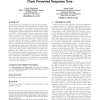1746 search results - page 32 / 350 » Understanding Semantic Web Applications |
WWW
2005
ACM
14 years 10 months ago
2005
ACM
We describe Thresher, a system that lets non-technical users teach their browsers how to extract semantic web content from HTML documents on the World Wide Web. Users specify exam...
ICSE
2004
IEEE-ACM
14 years 9 months ago
2004
IEEE-ACM
Semantic Web, the next generation of Web, gives data well-defined and machine-understandable meaning so that they can be processed by remote intelligent agents cooperatively. Onto...
HCSE
2010
13 years 7 months ago
2010
The pitch-based input (humming, whistling, singing) in acoustic modality has already been studied in several projects. There is also a formal description of the pitch-based input w...
SIGMETRICS
2006
ACM
14 years 3 months ago
2006
ACM
Understanding and managing the response time of web services is of key importance as dependence on the World Wide Web continues to grow. We present Remote Latency-based Management...
ESWS
2004
Springer
14 years 3 months ago
2004
Springer
The next Web generation promises to deliver Semantic Web Services (SWS); services that are self-described and amenable to automated discovery, composition and invocation. A prerequ...

